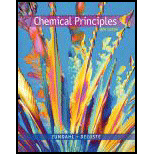
a)
Interpretation: Effect of reaction mixture at equilibrium as
Concept introduction: In accordance to Le Chatelier’s principle, change in reaction condition brings changes in position of equilibrium and shifts equilibrium in that direction that tends to decrease the change. It states that on addition of reactant or product in a reaction, shifts the equilibrium in the direction of decreasing the added amount. Whereas on removal of reactant or product in reaction, shifts the equilibrium in the direction of increasing the amount removed.
b)
Interpretation: Effect of reaction mixture at equilibrium as temperature of endothermic reaction is increased in below reaction is to be determined.
Concept introduction: In accordance to Le Chatelier’s principle change in reaction condition brings changes in position of equilibrium and shifts equilibrium in that direction that tends to decrease the change. It states that for an endothermic reaction increase in temperature tends to shift equilibrium in forward direction and for exothermic reaction it shifts in backward direction.
c)
Interpretation: Effect of reaction mixture at equilibrium as pressure inert gas is added in below reaction is to be determined.
Concept introduction: In accordance to Le Chatelier’s principle change in reaction condition brings changes in position of equilibrium and shifts equilibrium in that direction that tends to decrease the change. It states that with increase in pressure of container its volume decreases. Increase in volume shifts equilibrium in that direction that increases the overall volume. Decrease in volumes shifts equilibrium in that direction that has less number of moles.
d)
Effect of reaction mixture at equilibrium as
Concept introduction: In accordance to Le Chatelier’s principle, change in reaction condition brings changes in position of equilibrium and shifts equilibrium in that direction that tends to decrease the change. It states that on addition of reactant or product in a reaction, shifts the equilibrium in the direction of decreasing the added amount. Whereas on removal of reactant or product in reaction, shifts the equilibrium in the direction of increasing the amount removed.
e)
Interpretation: Effect of reaction mixture at equilibrium as volume is tripled in below reaction is to be determined.
Concept introduction: In accordance to Le Chatelier’s principle change in reaction condition brings changes in position of equilibrium and shifts equilibrium in that direction that tends to decrease the change. It states that with increase in pressure of container its volume decreases. Increase in volume shifts equilibrium in that direction that increases the overall volume. Decrease in volumes shifts equilibrium in that direction that has less number of moles.
Want to see the full answer?
Check out a sample textbook solution
Chapter 6 Solutions
Chemical Principles
- One liter of chlorine gas at 1 atm and 298 K reacts completely with 1.00 L of nitrogen gas and 2.00 L of oxygen gas at the same temperature and pressure. A single gaseous product is formed, which fills a 2.00 L flask at 1.00 atm and 298 K. Use this information to determine the following characteristics of the product:(a) its empirical formula;(b) its molecular formula;(c) the most favorable Lewis formula based on formal charge arguments (the central atom is N);(d) the shape of the molecule.arrow_forwardHow does the square root mean square velocity of gas molecules vary with temperature? Illustrate this relationship by plotting the square root mean square velocity of N2 molecules as a function of temperature from T=100 K to T=300 K.arrow_forwardDraw product B, indicating what type of reaction occurs. F3C CF3 NH2 Me O .N. + B OMearrow_forward
- Benzimidazole E. State its formula. sState the differences in the formula with other benzimidazoles.arrow_forwardDraw product A, indicating what type of reaction occurs. F3C CN CF3 K2CO3, DMSO, H₂O2 Aarrow_forward19) Which metal is most commonly used in galvanization to protect steel structures from oxidation? Lead a. b. Tin C. Nickel d. Zinc 20) The following molecule is an example of a: R₁ R2- -N-R3 a. Secondary amine b. Secondary amide c. Tertiary amine d. Tertiary amidearrow_forward
- pls helparrow_forwardpls helparrow_forward35) Complete the following equation by drawing the line the structure of the products that are formed. Please note that in some cases more than one product is possible. You must draw all possible products to recive full marks! a. ethanol + 2-propanol + H2SO4 → b. OH conc. H2SO4 CH2 H3C CH + K2Cr2O7 C. d. H3C A pressure CH3 + H2 CH Pt catalystarrow_forward
 Chemistry for Engineering StudentsChemistryISBN:9781337398909Author:Lawrence S. Brown, Tom HolmePublisher:Cengage Learning
Chemistry for Engineering StudentsChemistryISBN:9781337398909Author:Lawrence S. Brown, Tom HolmePublisher:Cengage Learning Chemistry: The Molecular ScienceChemistryISBN:9781285199047Author:John W. Moore, Conrad L. StanitskiPublisher:Cengage Learning
Chemistry: The Molecular ScienceChemistryISBN:9781285199047Author:John W. Moore, Conrad L. StanitskiPublisher:Cengage Learning Chemistry & Chemical ReactivityChemistryISBN:9781133949640Author:John C. Kotz, Paul M. Treichel, John Townsend, David TreichelPublisher:Cengage Learning
Chemistry & Chemical ReactivityChemistryISBN:9781133949640Author:John C. Kotz, Paul M. Treichel, John Townsend, David TreichelPublisher:Cengage Learning ChemistryChemistryISBN:9781305957404Author:Steven S. Zumdahl, Susan A. Zumdahl, Donald J. DeCostePublisher:Cengage Learning
ChemistryChemistryISBN:9781305957404Author:Steven S. Zumdahl, Susan A. Zumdahl, Donald J. DeCostePublisher:Cengage Learning Chemistry: An Atoms First ApproachChemistryISBN:9781305079243Author:Steven S. Zumdahl, Susan A. ZumdahlPublisher:Cengage Learning
Chemistry: An Atoms First ApproachChemistryISBN:9781305079243Author:Steven S. Zumdahl, Susan A. ZumdahlPublisher:Cengage Learning





